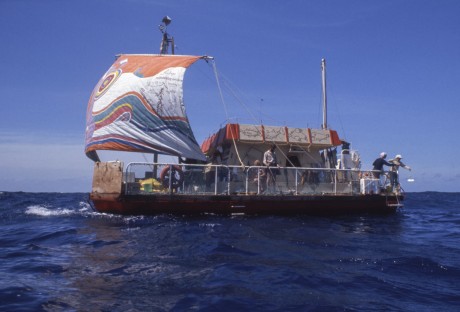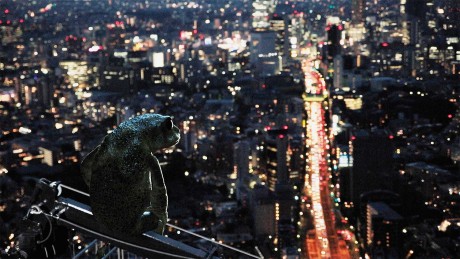”I’ll try to tell you the story”, says the weak old man in a blue shirt with a hat on his head. He is adressing the camera crew. ”I was 22 in 1947”, the year that is the focus of the film, the year when a rebellion took place led by the ”Fahavalo”, the enemies it means, against the French who had colonised Madagascar. An uprising against the Vazaha, the French, the Europeans. He was one of the freedom fighters and he paid his price, 8 years and 9 months in prison. The rebels were hiding in the forests and long after they were defeated, many of them were still there.
That old man is just one of the storytellers in the film. A handful of other men and women still alive are the witnesses found and involved in the film by the filmmakers. In conversations, which are conversations and not interviews – and conversations that most of the time include listeners, relatives, children and grandchildren, who want to hear and – you sense that – are proud of what they did back then. The tellers are mostly ordinary (hate that word) people but there are also some, who have studied this crucial point in the Malagasy history… The way they talk is wonderful. They like to bring to life the dramatic stories about what happened, and about how life was, these 70 years ago, and they often do it in a flowerish, metaphoric language, helped by questions from the film crew. It is no secret that there is a film crew, who asks and respects and are curious on behalf of the viewer. Oral history at its best. At one sequence one of the old men starts his talk but is interrupted by one of the relatives, who says ”don’t talk so much, get to the point”, but behind the camera the filmmakers object: Let him talk. This is why one gets to love the people in the conversations: they are given space to express themselves. And it is an evidence of the love and cinematic competence the filmmakers have dedicated to the film.
A few words more on Malagasy history at that time: During WW2 many Malagasy men were going to Europe to fight with the French against the Germans. At the same time the official Madagascar was supporting the French Vichy government led by Marechal Pétain. For that reason the English occupied Madagascar during WW2. After the war the soldiers came back – for their support to France de Gaulle had promised them independence. It did not happen. Instead Madagascar became a part of France Union, a colony. This disappointment led to the rebellion. As one says: ”A lot of Malagasy blood was spilled back then”. Another sweet old man says that “de Gaulle colonised us to help us”!
The film is built as a journey in history and literally to find the survivors. Along and through mountain tunnels, passing lakes and rivers, bigger and smaller villages, inside and outside houses. The Film as a Film is excellent. Content and form go hand in hand. The scoop is that at the same time as you experience a historical event told as old men and women remember it – the insurrection against power and colonialism – it is also, through the images, giving the viewer a sense of the island of today. Daily hard life in the countryside as it was also at that time, like building a house from clay, carrying food and goods in baskets on their heads, cooking at a fireplace outside… With rituals like the Sikidy – I am not able to tell you what it is, but fascinating to watch.
A sequence to make you understand the way the film is shifting from then to now and back again: A man talks about the many rebels who were being killed in battles, where they fought with spears and machetes against guns and knives; cut to a poor cemetery where you find the inscription ”The Tomb of the Brave”; cut to a lake where a lonely man in a canoo is paddling; cut to the same motif in the past in one of the extraordinary black/white archive scenes that the film is full of; cut to animals crossing a river… and all that accompanied by the captivating accordéon music composed by Régis Gizavo, who is from Madagascar. It’s superb!
And I love the long scenes like the one, where a boy is cutting wood meant to give fire with a big knife. It is no surprise for me, who knows what cameraperson César Paes has been doing before together with Marie-Clémence as producer and co-director; he has ”a documentary eye” and knows a poetic situation, when he feels or sees one. There are many.
On the photo above you see cameraman César Paes, assistant director and set photographer Tiago Paes, Berthe Raharisoa, in her white dress, a lively lady, born in 1925, who was part of the MDRM. In the film she sings the anthem of the resistance party. Lovely!
And to the right director and producer Marie Clémence Andriamonta Paes, as the name indicates she is half Malagasy, half French. It is of course a huge advantage that she speaks the language and can communicate directky with the witnesses.
All I know about Madagascar, I know from Marie-Clémence and César Paes and their films. Way back from the 1989 “Angano… Angano”. That we bought for distribution in Denmark. It is so beautiful and well shot that our grand master of Danish documentary, Jørgen Roos, thought it was shot on 35mm film. Thank you for that and “Mahaleo” and more films and let this new wonderful film travel!
France, 2018, 90 mins.
http://fahavalo-film.com








